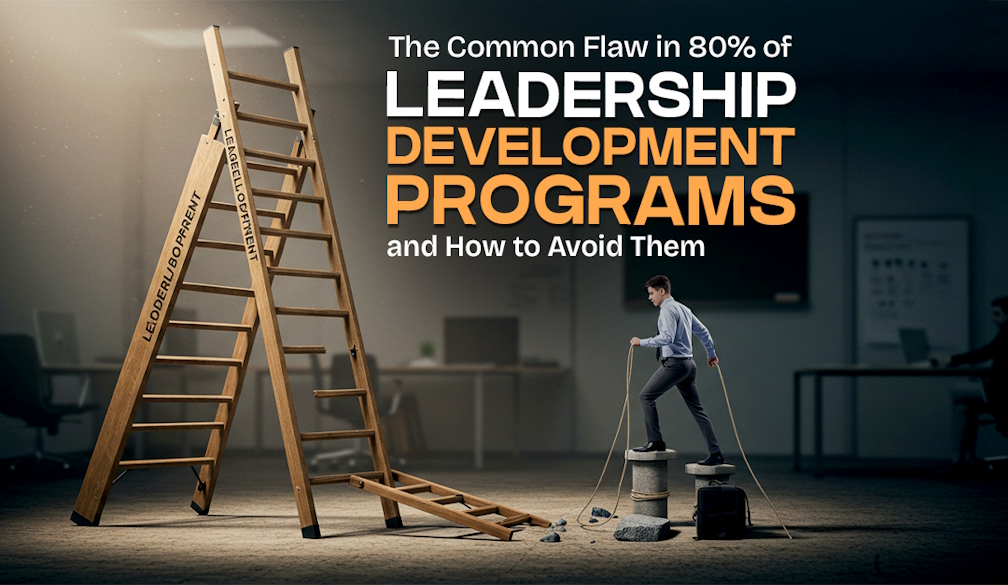The Common Flaw in 80% of Leadership Development Programs and How to Avoid Them

This article reveals why nearly 80% of leadership development programs fail to create a lasting impact. Read it to the end to learn the common flaw that undermines success and explore practical strategies to avoid it!
Did you know that nearly 80% of leadership development programs fail to deliver real results? Organisations invest heavily in training future leaders, yet most initiatives fall short of creating lasting change. These programs fail not because of a lack of effort or resources, but because of their structure.
Too often, companies focus on theory instead of practice and apply a one-size-fits-all approach. As a result, these programs inspire participants but leave them unprepared to lead in real situations. This article explores the most common flaws behind these failures. It offers practical solutions to design the best development leadership programs that truly empower individuals and drive long-term organisational success.
Must-Know Points:
Here’s what you’ll learn in this article:
- Leadership development fails when programs lack clear objectives and alignment with organisational goals.
- A one-size-fits-all approach reduces relevance, so programs must be tailored to career stages and roles.
- Lasting leadership skills come from practice, feedback, and real-world application, not just theory.
- Strong executive sponsorship and cultural alignment are crucial for program credibility and success.
- Measuring outcomes with clear KPIs ensures ROI and continuous improvement of leadership initiatives.
- Leadership growth is a long-term journey requiring sustained coaching, mentorship, and soft skills focus.
Overview of Leadership Development Programs
According to the Harvard Business School, leadership development programs are structured initiatives designed to create the skills required to succeed in leadership roles. They often combine to prepare employees for more responsibility, evaluation, and experiential learning.
The purpose of these programs is to increase important abilities like decision-making, communication, problem-solving, and strategic thinking to promote adaptability in a vibrant business environment.
Organisations invest in leadership development to ensure a stable pipeline of competent leaders who can run development, innovation, and employee engagement. As per Global Insight Services, the leadership development program market is anticipated to expand from $3.9 billion in 2023 to $7.5 billion by 2033.
Studies show that many programs fail despite heavy investment because poor design and weak alignment with organisational culture limit their impact. To build effective leaders, organisations need clear goals and ongoing support beyond the classroom.
9 Common Flaws in Leadership Development Programs and How to Avoid Them
Think of a company that spends thousands on a leadership program. The workshops are exciting. The speakers are inspiring. For a while, everything feels new. But a few months later, nothing has really changed. Studies show that almost 80% of these programs fail to make a lasting impact. The problem isn’t money or effort. The issue lies in poor design, weak delivery, and a lack of connection to real-life challenges.
That’s why leadership development has become a popular topic for students. They are asked to analyse why so many programs fail and what could be done differently. But digging deep into research and turning it into a strong analysis isn’t always easy. When students find themselves stuck, getting expert help can make all the difference. The Academic Papers UK offers AI-free essay writing services that guide them in organising their research and presenting it in papers clearly.
Below are nine common mistakes organisations make in leadership development programs, along with practical ways to avoid them.
1: Lack of Clear Objectives
Many corporate leadership training programs launch without well-defined goals. Instead of identifying specific skills and behaviours, leaders need to be successful; organisations adopt a generic framework that looks good on paper but fails to align with business realities.
Without clear objectives, programs lack direction, which makes it impossible to evaluate progress or justify investment. Participants are uncertain about what success seems, while organisations fail to see the average result.
How to Avoid It:
- Start with an evaluation that examines organisational goals, leadership gaps, and industry challenges.
- Define smart objectives for the program (Specific, Measurable, Achievable, Relevant, and Time-bound).
- Align leadership skills with the strategic priorities of the company. For example, a technical startup can prioritise agility and innovation, while a healthcare organisation can emphasise sympathy and regulatory compliance.
2: One-Size-Fits-All Approach
Many organisations use standardised training modules for all participants, assuming that the same leadership skills apply universally. While this approach is cost-effective, it ignores the roles, experiences, and diversity of personalities within the organisation.
Leaders of different levels face different challenges. For the first time, the observer requires skill in team management, while a senior executive may need to focus on organisational strategy and stakeholder management. The same treatment with them reduces the relevance and connectivity of the program.
How to Avoid It:
- Create a tier program to suit career stages (emerging leaders, middle-level managers, senior officials).
- Provide adaptable teaching paths that enable participants to select relevant modules based on their roles.
- Include personal assessment (eg, 360-degree response, personality test) to personalise learning purposes.
3: Insufficient Focus on Practical Application
Many leadership programs, executive leadership programs for professionals, emphasise theory lectures, slides, and abstract models without providing practice opportunities. Participants understand the concepts intellectually but struggle to apply them in real-world situations.
Leadership is best learned. Without practical application, knowledge quickly fades, and participants return to older behaviours under pressure.
How to Avoid It:
- Integrate action learning projects, where participants deal with real business challenges during the program.
- Use role-playing exercises, simulation, and case studies to mirror the dynamics of the workplace.
- Encourage participants to apply a lesson to their teams immediately, followed by structured reflections and coaching.
4: Limited Executive Sponsorship
Leadership coaching and mentoring programs often lack visual support from top leadership. Officers may approve funds, but may fail actively to participate, indicating that leadership development is not a real priority.
When employees disengage senior leaders, they believe that the program is a formality rather than a meaningful investment. Without executive sponsorship, the initiative loses reliability and speed.
How to Avoid It:
- Secure active sponsorship from senior leaders to champion the program. Encourage them to turn participants into champions and share their own leadership experiences.
- Include officers in the program design to align the material with strategic goals.
- Celebrate the stories of success in public, strengthening leadership development as a valuable organisational priority.
5: Poor Feedback Mechanisms
Leadership development often lacks effective response loops. Participants get very little guidance on their progress, while organisations fail to catch the insight that can improve future programs. Without response, participants cannot identify blind spots or track growth. Similarly, organisations recall opportunities to refine their attitude based on real experiences.
How to Avoid It:
- Include a 360-degree response to the leaders to provide them with a comprehensive understanding of their strengths and weaknesses.
- Build in regular coaching sessions to track learning and progress.
- Use surveys and focus groups to collect data on areas for the effectiveness and improvement of the program.
6. Inadequate Measurement of Program Effectiveness
Organisations often invest heavily in leadership development programs but fail to measure the results effectively. They rely on attendance numbers or satisfaction surveys rather than solid performance metrics.
Without measurement, it is impossible to prove or identify returns on investment, which elements of the program actually work. This leads to wasted resources and doubts about the training initiative.
How to Avoid It:- Define major performance indicators before starting the program (e.g, employee engagement, retention rate, promotion readiness, success of the project).
- Use the Kilkpatrick model (reaction, learning, behaviour, result) to evaluate results at several levels.
- Link program results for business metrics, such as revenue growth, customer satisfaction, or operational efficiency.
7. Overlooking Soft Skills
Many programs emphasise technical and strategic skills, such as financial or project management, ignoring soft skills such as emotional intelligence, sympathy, and communication.
Research continuously indicates that soft skills separate effective leaders from the average. Leaders who lack mutual skills struggle to inspire teams, resolve conflicts, or promote cooperation. Students can discuss such points when writing leadership essays.
How to Avoid It:
- Include emotional intelligence training, focus on self-awareness, sympathy, and flexibility.
- Teach communication and conflict resolution skills through role-playing and peer feedback.
- Balance technical content with human-focused leadership practices.
8: Short-Term Focus
Many affordable leadership programs are a quick fix. A three-day workshop or a short seminar can make people feel excited for a while. But soon, without practice, they forget the lessons and go back to old habits. It is the same as when students use essay writing companies with human writers. The essays may solve the problem for the moment, but real learning happens only when they keep practising and improving their own skills.
Good leadership development is not a one-time event. It is a long process that needs regular practice, guidance, and real experience to bring lasting change.
How to Avoid It:
- Design a constant learning journey that lasts more than months or years.
- Provide ongoing coaching and mentorship to maintain development.
- Encourage colleagues, learning communities, or an alumni network to share accountability and knowledge.
9: Ignoring Organisational Culture
Leadership development programs sometimes ignore the company's unique culture, values , and operating environment. Training can introduce practices that struggle with the existing criteria of the organisation, create confusion, or resistance.
Leadership grows within people and their environment. It is deeply influenced by organisational culture. A program that fails to reflect cultural realities will feel irrelevant and impractical.
How to Avoid It:
- Align the training material with the core values and missions of the organisation.
- Use real examples from the company's history to make the lesson reliable.
- Include employees of diverse departments in shaping the program, and ensure that it resonates with a comprehensive workforce.
Top 10 Leadership Development Programs
Here is a list of the 10 best leadership development programs you must consider:
- Harvard Business School – Program for Leadership Development
- Centre for Creative Leadership (CCL) – Leadership Development Program
- Wharton Executive Education – Executive Development Program (EDP)
- MIT Sloan – Transforming Your Leadership Strategy
- Harvard Business School – Advanced Management Program (AMP)
- Oxford Senior Executive Leadership Programme
- Stanford Executive Program (SEP)
- IMD – Executive Education (Open & Custom Programs)
- London Business School – Senior Executive Programmes
- INSEAD – Leadership Programme for Senior Executives (ILPSE)
Conclusion
While the leadership development programs have immense potential, they fail due to several flaws. From unclear purposes to ignoring soft skills or the culture, these misunderstandings weaken the intended outcomes.
Finally, leadership development should be seen not as a training program but as a strategic investment in people and culture. When thinking is done and executed with care, these programs can turn individuals into competent leaders who motivate teams, drive innovation, and move towards permanent success.
Do leadership development programs actually work?
Yes, leadership development programs can be highly effective to suit well-designed and organisational needs. They improve communication, strategic thinking, decision-making, and emotional intelligence.
Their success depends on practical application, ongoing reaction, and alignment with the company's goals. Poorly structured programs, however, may fail to create permanent behaviour changes, which make adaptation and follow-up difficult.
Which leadership skills are taught in leadership development programs?
Leading development programs usually focus on main skills such as communication, conflict resolution, decision making, and emotional intelligence. They also teach strategic thinking, adaptability, and team inspiration.
Participants learn to manage change, develop flexibility, and strengthen cooperation. Some programs emphasise moral leadership, innovation, and cultural ability to prepare leaders for diverse, modern workplace challenges.
Who should participate in a leadership development program?
Leadership development programs are valuable for emerging leaders, middle-level managers, and senior officials seeking development. High-capacity employees can benefit by preparing for future leadership roles.
Teams passing through infections or organisations facing change can also benefit from these programs. Essentially, anyone wants to strengthen leadership abilities and make a positive contribution to organisational success.
How long does a leadership development program usually last?
The duration of leadership development programs varies widely depending on depth and objectives. Some small workshops last for a few days or weeks, while comprehensive programs last for months or a year.
The ongoing coaching and mentorship can stay beyond the formal time limit, ensuring practical applications. The most effective programs provide continuous teaching rather than one-time training.
What is the difference between leadership development and management training?
Leadership development focuses on long-term development, strategic vision, and inspiring others, emphasising emotional intelligence and innovation. In contrast, management training is more operational, teaching skills such as planning, budgeting, process control, and performance evaluation.
While the management ensures efficiency, the leadership motivates the direction. Both are necessary, but leadership development creates an impact and vision, while the management training ensures organisational stability.
How to measure the success of leadership development programs?
The success of leadership development programs can be measured through participant response, observation of behaviour changes, and better team performance. Major indicators include high employee engagement, retention, and productivity.
Organisations can also track leadership pipeline readiness and the ROI Matrix. Long-term success is clear when participants implement skills learned effectively, resulting in both personal development and organisational results.
References
- Harvard Business School, Feb 23, 2024, How to Create a Successful Leadership Development Program, retrieved from: https://www.harvardbusiness.org/insight/how-to-create-a-successful-leadership-development-program/
- Global insight services, retrieved from: https://www.globalinsightservices.com/reports/leadership-development-program-market/








